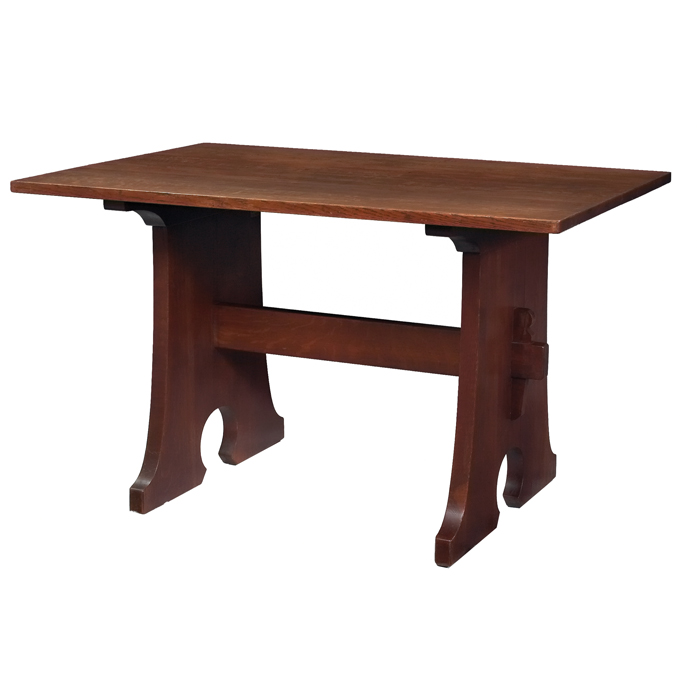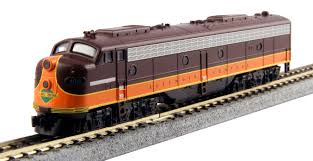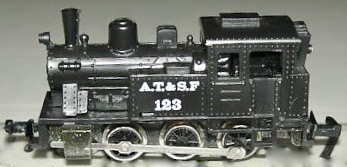Description: Keyhole Trestle Table
Dimensions: 48" Wide x 32" Deep x 29" High
Info: Mission style furniture is characterized by broad, straight horizontal and vertical lines . The furniture is usually comprised of oak with a distinct dark finish. The designs are simple and elegant with little embellishment, illustrating the simplicity and durability of the pieces.
Tables are usually secured at intersections by joints called splines to strengthen the severe straight lines and plain surfaces. Handles and any trimmings are made from copper or iron. Tables can also include additional features such as drawers, extensions, and shelves.
Tables are usually secured at intersections by joints called splines to strengthen the severe straight lines and plain surfaces. Handles and any trimmings are made from copper or iron. Tables can also include additional features such as drawers, extensions, and shelves.
History:
The Stickley brothers were all born in Wisconsin, but they settled in upstate New York and Grand Rapids. There were five brothers in the family: Gustav (1858-1942), Charles (1860-1927), Albert (1862-1928), Leopold (1869-1957) and John George (1871-1921). While Gustav Stickley was the oldest and is credited with creating Mission Furniture as a unified style, all five brothers were active in producing Arts & Crafts and Mission Furniture under various trade names and in different partnerships over the years.
Leopold Stickley helped his brother Gustav as foreman in the first years, but in 1902 he formed the Onondaga Shops in Fayetteville, NY with John George Stickley, perhaps with Gustav's encouragement, as it appears Onondaga Shops took over Gustav's contracts to produce furniture for Toby Furniture in Chicago, and possibly others.
Onondaga Shops name gave way to L&JG Stickley in 1907, marking furniture from 1907-1912 with a decal that read, " Handcraft L&JG Stickley". In 1912, the furniture signature changed to "The Work of L&JG Stickley".
Stylistically and ideologically, the designs of Gustav Stickley and L.& J.G. Stickley are quite similar: exemplifying a mantra of "honest," durable work, the furniture features simple, rectilinear lines, exposed joinery, decoration limited to hand-hammered hardware. It's usually made of oak. The main differences are in the details, recognizable mainly to Stickley scholars. Straying a bit from Gustav's boxy, sharp-edged ideal, L. & J.G's works often have more fluid curves. Their tenon-locking keys are faceted, not rounded. Gustav's adjustable chairs used movable pegs, while his brothers used crossbars.
But the younger brothers' furniture "has long been considered of secondary importance," as Jonathan Fairbanks and Elizabeth Bates put it in American Furniture: 1620 to the Present. This is partly because Gustav - along with Harvey Ellis, an architect who worked with him - seems to have been the true design originator; L. & J.G's pieces often seem derivative, appearing in their catalogs a year or two after Gustav's. Many antiques experts also feel that Gustav's pieces are more elegant, more finely-tuned in proportion and detail. Sometimes, L & J.G. also used lesser-quality secondary woods.
Ironically, L & J.G. often charged higher prices than Gustav did, according to Furniture of the American Arts and Crafts Movement. Today, however, works by Gustav Stickley fetch far more than his brothers' - due to their superiority, their creator's "designer" name, and their comparative scarcity. Gustav's furniture company lasted 16 years, while Leopold and John George's continued until the 1970s (though they only produced Arts and Crafts furniture through 1923).
L&JG Stickley actively competed for the same customers as Gustav Stickley's Craftsman Workshops. Some acrimony can be seen in an excerpt from Gustav's 1907 catalog "some of my most persistent and unscrupulous imitators bear the same name as myself, and this fact is used to confuse purchasers".
Leopold and John George proved more successful on the business side of making furniture than their elder brother, Gustav, and eventually acquired Gustav Stickley's Craftsman Workshops in 1918, joining the two major Mission furniture lines.
The Stickley brothers were all born in Wisconsin, but they settled in upstate New York and Grand Rapids. There were five brothers in the family: Gustav (1858-1942), Charles (1860-1927), Albert (1862-1928), Leopold (1869-1957) and John George (1871-1921). While Gustav Stickley was the oldest and is credited with creating Mission Furniture as a unified style, all five brothers were active in producing Arts & Crafts and Mission Furniture under various trade names and in different partnerships over the years.
Leopold Stickley helped his brother Gustav as foreman in the first years, but in 1902 he formed the Onondaga Shops in Fayetteville, NY with John George Stickley, perhaps with Gustav's encouragement, as it appears Onondaga Shops took over Gustav's contracts to produce furniture for Toby Furniture in Chicago, and possibly others.
Onondaga Shops name gave way to L&JG Stickley in 1907, marking furniture from 1907-1912 with a decal that read, " Handcraft L&JG Stickley". In 1912, the furniture signature changed to "The Work of L&JG Stickley".
Stylistically and ideologically, the designs of Gustav Stickley and L.& J.G. Stickley are quite similar: exemplifying a mantra of "honest," durable work, the furniture features simple, rectilinear lines, exposed joinery, decoration limited to hand-hammered hardware. It's usually made of oak. The main differences are in the details, recognizable mainly to Stickley scholars. Straying a bit from Gustav's boxy, sharp-edged ideal, L. & J.G's works often have more fluid curves. Their tenon-locking keys are faceted, not rounded. Gustav's adjustable chairs used movable pegs, while his brothers used crossbars.
But the younger brothers' furniture "has long been considered of secondary importance," as Jonathan Fairbanks and Elizabeth Bates put it in American Furniture: 1620 to the Present. This is partly because Gustav - along with Harvey Ellis, an architect who worked with him - seems to have been the true design originator; L. & J.G's pieces often seem derivative, appearing in their catalogs a year or two after Gustav's. Many antiques experts also feel that Gustav's pieces are more elegant, more finely-tuned in proportion and detail. Sometimes, L & J.G. also used lesser-quality secondary woods.
Ironically, L & J.G. often charged higher prices than Gustav did, according to Furniture of the American Arts and Crafts Movement. Today, however, works by Gustav Stickley fetch far more than his brothers' - due to their superiority, their creator's "designer" name, and their comparative scarcity. Gustav's furniture company lasted 16 years, while Leopold and John George's continued until the 1970s (though they only produced Arts and Crafts furniture through 1923).
L&JG Stickley actively competed for the same customers as Gustav Stickley's Craftsman Workshops. Some acrimony can be seen in an excerpt from Gustav's 1907 catalog "some of my most persistent and unscrupulous imitators bear the same name as myself, and this fact is used to confuse purchasers".
Leopold and John George proved more successful on the business side of making furniture than their elder brother, Gustav, and eventually acquired Gustav Stickley's Craftsman Workshops in 1918, joining the two major Mission furniture lines.
Item created by: gdm on 2015-08-20 07:13:47
If you see errors or missing data in this entry, please feel free to log in and edit it. Anyone with a Gmail account can log in instantly.
If you see errors or missing data in this entry, please feel free to log in and edit it. Anyone with a Gmail account can log in instantly.







